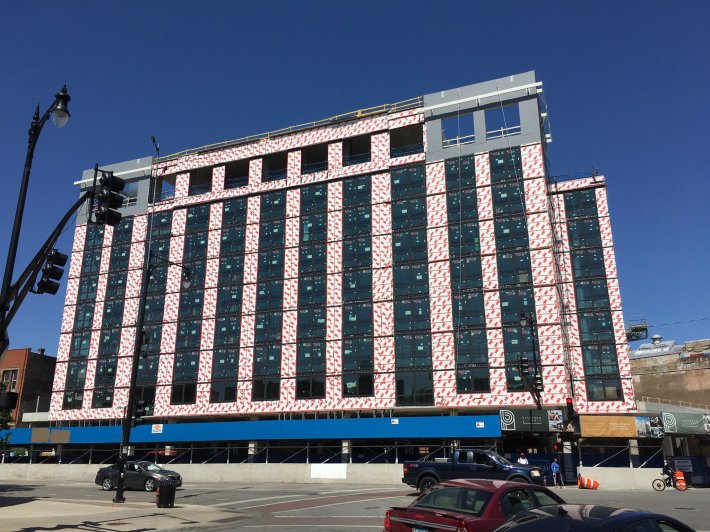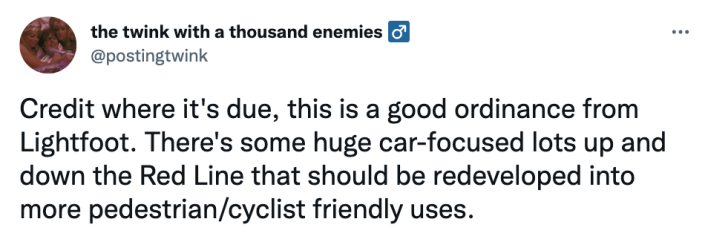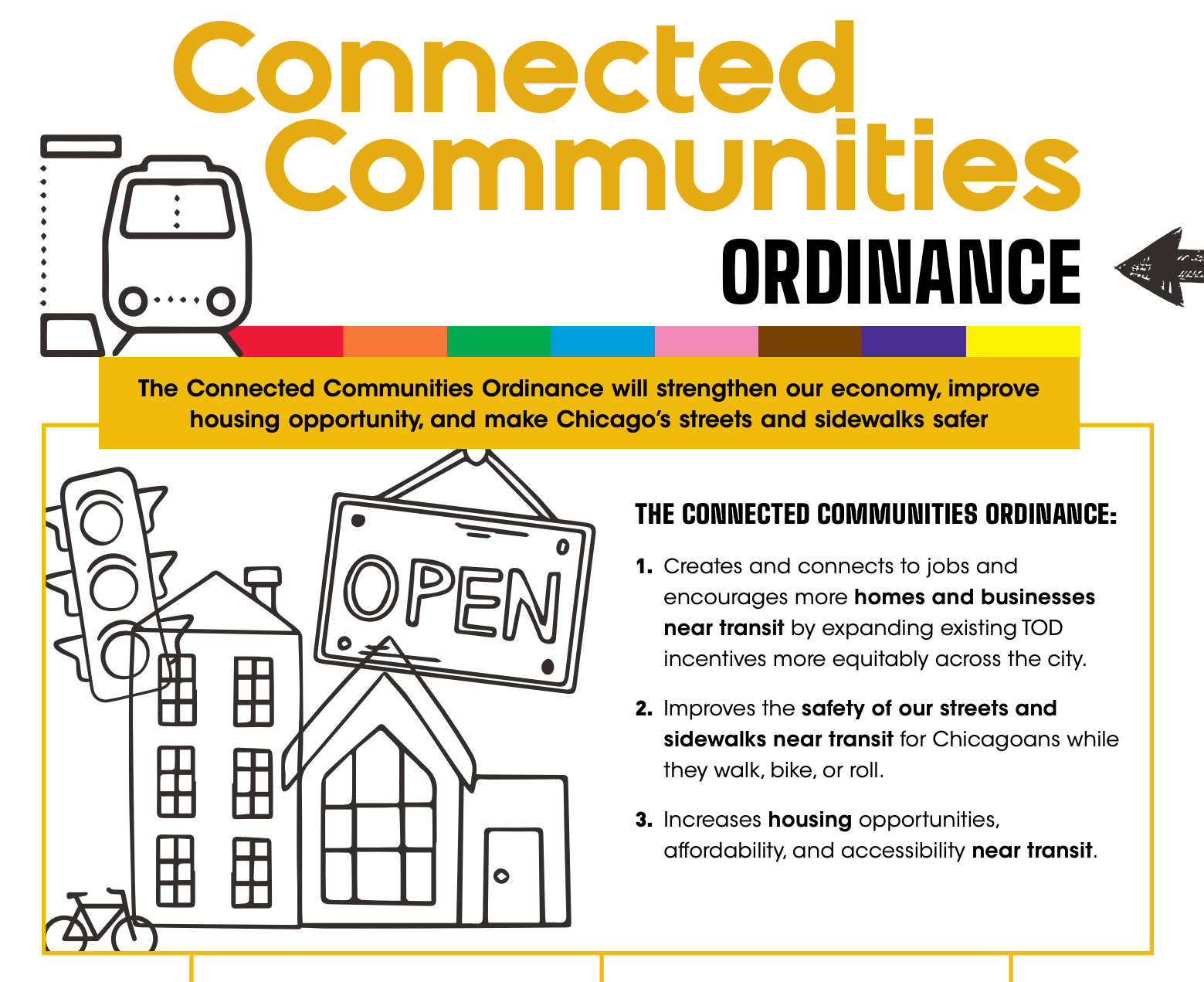Yesterday I discussed lots of things that are good about Chicago.
As for our city's problems, many or most of them are associated with two things. Racial and economic segregation, which concentrates poverty on the South and West sides, makes it difficult for many residents to access educational and job opportunities, healthcare, and healthy food, and often exposes them to high levels of air pollution. It's a huge factor in Chicago's high levels of violence and shameful disparities in life expectancy between rich and poor neighborhoods.
And, as we often discuss on Streetsblog, our city's overly car-centric transportation system makes our streets more dangerous, less efficient, less healthy, and less vibrant. It also exacerbates segregation by making it even more difficult for people to access resources if they live in underserved neighborhoods and can't afford to drive.
Equitable transit-oriented development – building generous amounts of affordable housing near rapid and/or high-frequency public transportation – is a powerful tool to reduce both segregation and car-dependency. It makes it much easier for low-income and working-class residents to get to jobs, school, doctor's appointments, and quality retail, helping them build health and wealth without having to own a car.
Last month's opening of the Lucy Gonzalez Parsons Apartments, a 100-unit all-affordable development next to a CTA Blue Line station in the fast-gentrifying Logan Square neighborhood, was an inspiring example of the eTOD phenomenon. Although it faced stiff opposition from Not In My Back Yard types, the building is a great strategy to help prevent longtime community residents from being priced out of the area.
As reported by The Daily Line's Alex Nitkin, the Lori Lightfoot administration hopes to spur the development of more affordable, parking-lite housing near transit with the proposed "Connected Communities Ordinance." The legislation builds on the city's 2020 Equitable Transit Oriented Development Policy Plan, which outlined a comprehensive set of actions for officials to take over the next three years. The law would also make it more difficult for alderpersons to block eTOD proposals in their wards. However, the ordinance faces a fierce battle in the City Council.
While Streetsblog has been told city staffers are not allowed to share the latest draft of the ordinance, The Daily Line reported that Connected Communities includes almost a dozen measures to encourage transit-friendly housing and walkable streets near stations. An earlier draft of the legislation included doubling the size of the TOD zone around transit stations (where additional density is allowed and the usual car parking requirements of one space per unit are waived) from the current quarter-mile on most streets to a half-mile. The law would also permit the construction of relatively affordable two- and three-flat housing "as of right" – without the need for a zoning change approved by the alderperson – if the property is located within half a mile of an 'L' or Metra stop, or high-frequency bus line, in a wealthier North or Northwest Side community.

Other measures in the ordinance to promote affordability would include a requirement that every affordable development in a wealthier neighborhood area gets an up-or-down vote in the city's Zoning Committee, easing approval. The law would raise the minimum number of affordable units required in projects involving TOD density allowances. And it would allow developers in non-TOD areas to lower their parking requirements by including more affordable units.
While Chicago typically requires a minimum number of car parking spots at new developments, according to The Daily Line the draft ordinance also included Chicago's first parking maximum, a limit of no more than one space for every two apartments or condos. Another forward-thinking aspect of the proposal is a requirement for developers to get special permission from the city for new driveways within the TOD zones, which will help preserve walkability. Predictably, some alderpersons in more car-centric parts of town, and in disinvested areas where even a new drive-through fast food franchise is considered preferable to no development at all, aren't happy about these aspects of the legislation.
But progressive Near Northwest Side alder Daniel LaSpata told The Daily Line he plans to champion the new law. However, he'd like to see the measure include a fee for demolishing housing near transit, similar to a measure that was passed to fight housing displacement near the Bloomingdale Trail, aka The 606.
Read a fact sheet about the Connected Communities Ordinance here.
At a May 20 event, the mayor touted the ordinance and indicated it would be introduced soon, but that didn't happen at the most recent City Council meeting, according to The Daily Line. Lightfoot recently explained that the legislation needs some more edits before it's ready for its close-up. Earlier this week the Chicago Department of Housing said more time is needed to educate alderpersons about the new legislation, but the goal is to introduce the law at the June 22 Council meeting.

Roberto Requejo, executive director of Elevated Chicago, a nonprofit that promotes eTOD and helped coordinate the creation of the city's eTOD plan, said in a statement that Connected Communities will help get transit-friendly, affordable housing built all over the city. “You need only look at the differences between the activity around the Morgan station in the West Loop or the Blue Line stations along Milwaukee Avenue, on one hand, and at the vacant land around Green Line South or the 95th Street Red Line stations, on the other. The eTOD policy plan placed equity at the center of the way Chicago develops communities around transit infrastructure. This ordinance has teeth and makes equitable TOD the norm, rather than the exception.”
Active Transportation Alliance spokesperson Kyle Whitehead also praised the proposed ordinance. "This is a generational opportunity to create more affordable housing near transit and get more people walking, biking, and riding. The links between transportation and housing could not be clearer. People’s transportation choices are driven by where they live and where they need to go. This ordinance would help shift many of those decisions in the direction of safety, sustainability, and equity over the long term."
Metropolitan Planning Council transportation director Audrey Wennink is also a fan. "This is a great policy to encourage more homes and businesses near transit, improve the safety of streets and sidewalks near transit, and increase affordable, accessible housing near transit," she tweeted. "It will boost the sustainability and equity of Chicago development."
Streetsblog will take a deeper dive into the contents of the proposed ordinance in the near future.




